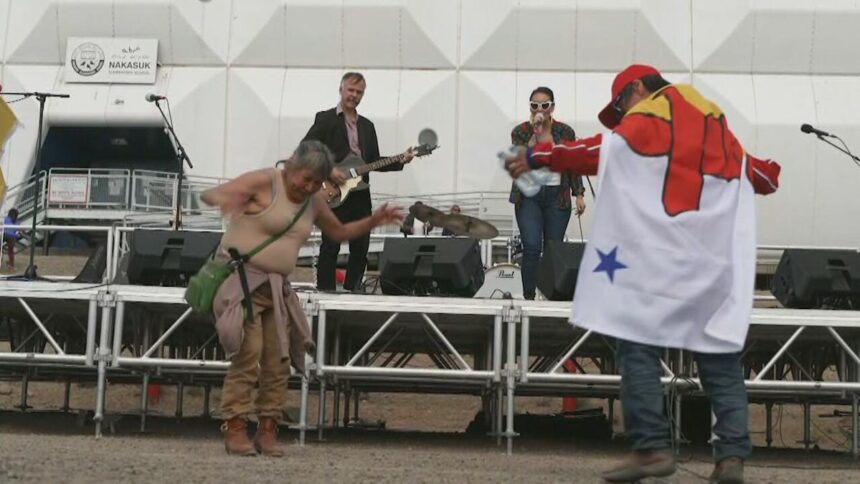As the rain clouds parted over Iqaluit on Tuesday afternoon, hundreds of residents gathered at Iqaluit Square for an annual celebration that means much more than a day off work.
Nunavut Day commemorates the passing of the Nunavut Land Claims Agreement Act on July 9, 1993, which paved the way for the territory’s creation in 1999. For many Nunavummiut, the day represents hard-won recognition after decades of advocacy.
“Today we celebrate our homeland, our culture, and the spirit of our people,” said Premier P.J. Akeeagok, addressing the crowd from a stage adorned with Nunavut flags. “This journey began long before many of us were born, with elders who envisioned a territory where Inuit could determine their own future.”
The premier’s words resonated with many in attendance, including 78-year-old Pauloosie Kilabuk, who remembers the long struggle for territorial recognition.
“I was there when we signed the agreement,” Kilabuk told me, adjusting his traditional sealskin hat. “Some of my friends who fought for this land are gone now, but their spirit is here today.”
This year’s celebrations featured a blend of traditional and contemporary elements. Local throat singers performed alongside Inuit rock band The Jerry Cans, whose energetic set had even the most reserved elders tapping their feet. Children raced through the square waving miniature Nunavut flags, their faces painted with territory emblems.
Food remained central to the festivities, with community members sharing country food including freshly prepared Arctic char, caribou stew, and bannock. The territorial government sponsored a massive community feast that served over 800 people, according to event coordinator Leetia Eegeesiak.
“Sharing food is fundamental to Inuit culture,” explained Eegeesiak. “We wanted everyone to feel welcome, whether they’ve lived here their whole lives or just arrived last month.”
Recent Statistics Canada data shows Nunavut maintains the youngest population in Canada, with a median age of just 25.8 years compared to the national average of 41.6. This demographic reality was visible throughout the celebrations, with young families predominant among attendees.
For younger Nunavummiut like 22-year-old throat singer Shina Novalinga, who performed at the event, Nunavut Day represents both heritage and future possibilities.
“My generation didn’t experience the struggle for our territory firsthand, but we carry that history,” Novalinga said. “We’re building something new while honoring what our grandparents fought for.”
The celebrations weren’t without acknowledgment of ongoing challenges. Housing shortages remain acute across the territory, with approximately 3,000 people currently on waiting lists for public housing according to the Nunavut Housing Corporation. Food security issues persist, with grocery prices in Iqaluit typically 2-3 times higher than southern Canada.
Louisa Pilakapsie, who operates a small craft business selling traditional sealskin products, expressed mixed emotions about the day.
“Of course I’m proud of our territory and what we’ve accomplished,” she said while arranging her display of handmade mitts and earrings. “But we can’t forget there’s still so much work to do. Our housing crisis is real. Food costs too much. These problems need solutions.”
The territorial government used the occasion to announce several new initiatives, including expanded language preservation programs and additional funding for community-led cultural activities. Minister of Culture and Heritage Joanna Quassa revealed a $2.7 million investment in Inuktitut language resources for schools and community centers.
“Our language carries our identity,” Quassa told the crowd to enthusiastic applause. “When we strengthen Inuktitut, we strengthen ourselves as a people.”
The day’s festivities extended beyond the main square, with smaller gatherings throughout Iqaluit. At the elders’ center, storytelling sessions attracted multi-generational audiences. The Nunatta Sunakkutaangit Museum opened a special exhibition of historical photographs documenting the territory’s journey to establishment.
Local businesses contributed to the celebration, with many offering special Nunavut Day promotions. The Black Heart Café served free coffee to the first 100 customers, while The Snack served discounted traditional foods all day.
Weather cooperated for most of the celebration, though brief afternoon showers sent some attendees seeking shelter. The unexpected rain didn’t dampen spirits – many participants noted that adapting to changing conditions is practically a territorial motto.
As evening approached, the celebration culminated in a community square dance that blended Scottish-influenced steps with Inuit drumming. Elders guided younger participants through traditional movements, creating a living bridge between generations.
“This is how we pass on who we are,” said dance leader Simon Nattaq. “Not just through words, but through movement and music that connects us to our ancestors.”
As the midnight sun kept the skies bright well into the evening, many reflected on the territory’s 25 years of existence – a young political entity built upon thousands of years of Inuit presence.
“Twenty-five years as a territory means we’re still finding our way,” said former Nunavut Commissioner Ann Meekitjuk Hanson. “But thousands of years of Inuit knowledge guides us. That’s what today celebrates – not just a political milestone, but the continuity of a people who have always belonged to this land.”






